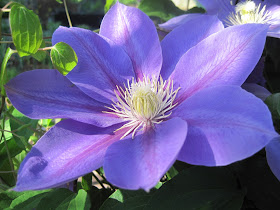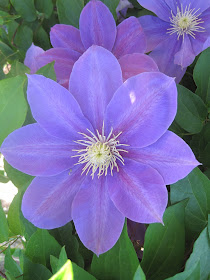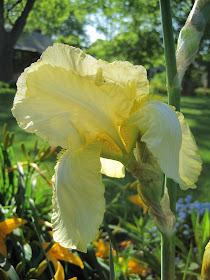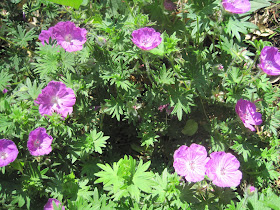 |
| Three more artichokes, 5/25/2012 |
Wednesday, May 30, 2012
More Artichokes
On May 25th, I harvested three more artichokes. They are very pretty, but you surely don't want to mess with the little spines all over the choke. It is best to snip them off with scissors before steaming the chokes. There are still two more chokes on the plant, for a total now of six.
First Tomatoes
I had my first tomatoes yesterday! Even before June! They are little, bitty tomatoes called Tiny Tim. And I am glad that I ate a couple, because they were gone today. Please don't tell me that the voles like tomatoes as their last salad course.
I have had the little plant in the cold frame for at least six weeks. The difficulty was not to keep it warm enough, but rather not to cook it when days were consistently in the sixties.
 |
| Tomatoes in May, 5/28/2012 |
I have had the little plant in the cold frame for at least six weeks. The difficulty was not to keep it warm enough, but rather not to cook it when days were consistently in the sixties.
Monday, May 28, 2012
Perennial Geranium
The true geranium, Geranium endressii, is a pretty little perennial that blooms here in Delaware in mid to late May. Some of our Forget Me Nots have moved in right next to clumps of the geraniums, making a nice combination of pastel colors.
 | |
| Perennial Geranium, 5/28/2012 |
Though they multiply by seed, they did it very slowly for me. The tap root is quite long for a fairly small plant, so dig a big chunk of soil out if transplanting. They tend to be very unhappy about a move if you whack off half of the tap root. They will send up a few flowers for much of the summer, and don't suffer too much from a drought. A very desirable addition to a perennial garden.
Monday, May 21, 2012
Mid May Blooms
 | |
| Siberian Iris, 5/18/2012 |
 |
| Butterfly Bed, 5/19/2012 |
 |
| Rob's Island Bed, 5/19/2012 |
 |
| My back garden, 5/18/2012 |
 |
| Shasta Daisies, 5/18/2012 |
 |
| Bletilla, 5/18/2012 |
 |
| Saint John's Wort, 5/18/2012 |
 |
| Mock Orange, 5/18/2012 |
 |
| Mock Orange |
 |
| Amaryllis, 5/20/2012 |
 |
| And that makes it happy |
Saturday, May 19, 2012
Ah, Artichoke
The primary stem artichoke was starting to open just a bit. I think that means it was starting to develop to the flowering stage, and away from the eating stage. Nope, not on my watch.
So I cut the choke off, and took him for a ride. We steamed him for dinner, and with melted butter for dipping, he sure was good. I hope the three remaining chokes will grow to at least this size.
When I harvested the choke, I took a lot of stem. Hoping the middle of the stem would have edible flesh like marrow in a bone. And it looked exactly like that from the cross section of the stem. And indeed was edible, with an even stronger flavor than the leaf petals. Future harvests will include the stem pieces.
There were quite a few sugar ants on the choke when I harvested it. They were farming some colonies of aphids living under the lowermost petals. The ants feed on the waste "honeydew" that the aphids produce. In return, the ants protect the aphids from predators. In some cases, the ants carry the aphid eggs back to the ant colony for winter storage, then return the eggs to proper plants in the spring. Thus increasing George's chances of having aphids. But overall, mostly harmless and totally organic. Removal of the worthless little bottom petals took care of both sets of critters.
 |
| My First Artichoke! 5/18/2012 |
When I harvested the choke, I took a lot of stem. Hoping the middle of the stem would have edible flesh like marrow in a bone. And it looked exactly like that from the cross section of the stem. And indeed was edible, with an even stronger flavor than the leaf petals. Future harvests will include the stem pieces.
There were quite a few sugar ants on the choke when I harvested it. They were farming some colonies of aphids living under the lowermost petals. The ants feed on the waste "honeydew" that the aphids produce. In return, the ants protect the aphids from predators. In some cases, the ants carry the aphid eggs back to the ant colony for winter storage, then return the eggs to proper plants in the spring. Thus increasing George's chances of having aphids. But overall, mostly harmless and totally organic. Removal of the worthless little bottom petals took care of both sets of critters.
Thursday, May 17, 2012
A Community Garden Benefit
For most of my gardening life, I have been a person who gives away the extra daffodil bulbs or tomatoes, or gasp, a bulb or two of garlic. Now maybe the saying "Tis better to give than to receive" might be politically correct, it is fun to receive as well on occasion. This morning I picked a bunch of extra scallions and stopped by a gardener's plot on my way out of the park. His nephew has a plot right next to his, and the nephew has swiss chard planted much too densely. Would I like to help out by thinning the chard patch? Well, yes.
These were very nice chard plants, probably just the right size to transplant. The larger ones went directly in the ground at my home garden. Smaller and bare rooted plants were replanted to cell packs, and placed in the shade to develop a good root system.
These plants probably will wilt badly and look like goners, but I expect they will be fine in a couple of days. I had good luck with some Swiss chard overwintering this year, so I am happy to get these plants. I did not mention in my blog my earlier disappointment about my Bright Lights swiss chard seedlings. Had several six packs of beautiful chard coming along. Put the flat out on the picnic table six weeks ago to harden off the plants. Are we thinking squirrel yet? Yep, they had themselves a lovely treat of minigreens. Right down to the nubs. The plants have survived by some miracle, and soon will be able to go into the ground to face their next battle.
But back to the park story. As I was really, really about to leave, the nephew asked if I liked radishes. Well, yes. By 8:30 AM, I had already eaten three small ones from my meager garden supply. Well, yes, I would love some radishes. I have had to practice great restraint to be able to put these in the fridge to share with my wife. Of course I had to taste test one of the small ones. Was it good? Well, yes. It was actually better than good. Actually scrumptious. Is it lunch time yet?
 |
| Swiss Chard transplants, 5/17/2012 |
 |
| Nice new Chard patch |
But back to the park story. As I was really, really about to leave, the nephew asked if I liked radishes. Well, yes. By 8:30 AM, I had already eaten three small ones from my meager garden supply. Well, yes, I would love some radishes. I have had to practice great restraint to be able to put these in the fridge to share with my wife. Of course I had to taste test one of the small ones. Was it good? Well, yes. It was actually better than good. Actually scrumptious. Is it lunch time yet?
Wednesday, May 16, 2012
Artichoke Update
 |
| Green Globe Artichoke plant, 5/16/2012 |
Friday, May 11, 2012
Friday's Flowers
More pictures for my archive, all taken May 11, 2012:
 |
| Yellow Bearded Iris |
 |
| Clematis, magenta |
 | ||
| Clematis, light purple |
 | |
| Same plant as last shot |
 |
| Yellow Bearded Iris, different clump, paler yellow |
 |
| Purple Columbine |
 |
| Dutchman's Breeches |
 |
| Bearded Iris, mixed purple |
 |
| Native Columbine |
 |
| Native Columbine, second shot |
 |
| Perennial Geranium |
 |
| Same plant as above |
 |
| Lonicera species, ornamental honeysuckle |
Wednesday, May 9, 2012
Early May Blooms
I took a walk about the yard on May fifth to snap some pictures of the flowers that were in bloom. This morning is gray and rainy, so it makes it nice to be looking at these pictures.
I love this purple clematis as it has wonderful color, yet is bright enough to really shine. This plant has is the parent to many surrounding babies. Though quite popular in my plant giveaway, I think there are still some available.
The Stella de Oro day lily is just coming into bloom. It has been popular in the giveaway, yet some clumps are big enough still to cut off more divisions.
And don't forget the "Forget Me Not". There are clumps everywhere, particularly in the middle of the beds where taller plants should be. They would appreciate a road trip.
Heading around the corner to go to the front yard, we pass a clump of perennial geraniums
. What a beautiful flower, and they will bloom off and on over the summer. They volunteer only sparingly, but are long lived.
I love this purple clematis as it has wonderful color, yet is bright enough to really shine. This plant has is the parent to many surrounding babies. Though quite popular in my plant giveaway, I think there are still some available.
 |
| Same plant, 5/5/2012 |
While this clematis is beautiful, the darker blooms just don't grab my attention the way the lighter purple ones do. Yet floating a flower in a cut glass bowl would be very pretty....
The Stella de Oro day lily is just coming into bloom. It has been popular in the giveaway, yet some clumps are big enough still to cut off more divisions.
 |
| Weigela |
 |
| Yellow Bearded Iris |
 |
| Native red columbine |
And don't forget the "Forget Me Not". There are clumps everywhere, particularly in the middle of the beds where taller plants should be. They would appreciate a road trip.
Heading around the corner to go to the front yard, we pass a clump of perennial geraniums
 |
| Closer shot of the flowers |
 |
| Delaware Valley White Azalea |
 |
| Rhododendron |
 |
| Wow! |
Tuesday, May 8, 2012
Artichoke Alert
I am so excited. I looked down into the artichoke plant that overwintered in the park garden, and what did I see? A little artichoke, of my very own. Wow. Cool. This was my third attempt at growing artichokes. Maybe it will be my first success.
 | |
| Artichoke bud, 5/8/2012 |
The choke has beautiful purple coloring at the bottom of the individual petals. Hope it keeps this coloring as it matures. I have another artichoke plant in a large flower pot that I moved onto the porch for the winter. Will move that pot out to the garden to get more sun.
The difficulty with growing artichokes is that they need to go through a cold cycle (vernalization) in order to set buds. Supposedly you can trick young plants into flowering by keeping them cold, but that did not work for me. And although they supposedly are able to survive the winter in my zone 7A garden, they often rot instead. At least they did until this year. From what I have read, I may get 4 to 5 chokes from this plant this year, and a plant is good for 4 to 5 years. They send off side shoots, so I hope I can separate the shoots to make more producing plants. All new to me.
This Green Globe Artichoke plant was sown 1/28/2011 from seed packaged for the year 2009 from Fedco Seeds. So I have been trying to grow artichokes since 2009, maybe this is the year! It did not set flower spikes in 2011 even though it was on the porch for the winter of 2011.
Two plants were planted over at the park for the summer of 2011, only this one survived the winter, though the second one came teasingly close to making it. Now I wonder if maybe the voles chewed the root of the second one. The following picture was taken 1/1/2012. Note the total lack of snow on the first of the year. Pretty much the total lack of snow for the entire winter. The plant on the right is the survivor.

Anybody out there who has grown artichokes? Would love to hear about your experience. Maybe I will go back over to the park now to see if it is any bigger.









